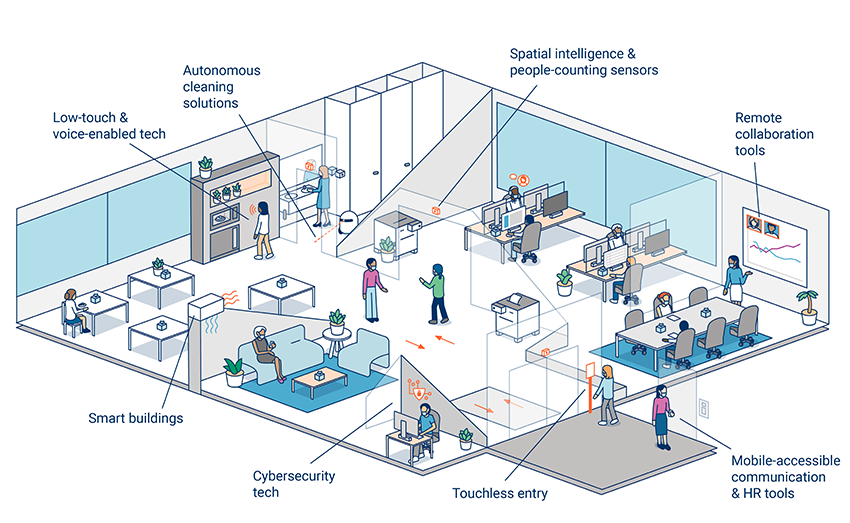
By Erns Wall, Interior Designer
A year ago, during what felt like an incredibly long 3-month period of working from home during the first lock-down, I was getting ready to get back to the office and ‘get back to normal’. A lot of people - myself included - were under the impression that by September of last year the worst would all be behind us and COVID-19 would simply be a blip in our collective memories. Unfortunately, this was not the case, and a year later we are finding ourselves in the throes of another wave. But there is a light at the end of the tunnel – as more people get vaccinated and we work towards herd immunity it is looking again like maybe – just maybe – things could start to get back to normal this year. Optimists are again saying September, but a recent poll revealed the consensus that ‘normal’ will not be back until the spring of next year.
Whether it is this year or next, the majority of office-based workers will eventually leave their temporary home offices in favour of going back to their employers’ physical office space. While working from home has been great for some people, a recent poll found that an overwhelming 85% of workers are looking forward to returning to the office in some capacity. However, things are not going to be exactly as they used to be. Two years (give or take) of living through a pandemic is going to have long-lasting effects on workers’ expectations for their office environment going forward. From the perspective of employees’ health and well-being, here are a few areas that are worth looking into to ensure your workforce feels safe and well taken care of as we navigate the return to the office.
 Cleaning and Sanitization
Cleaning and Sanitization
How often to you touch your face? Your hair? Your phone? How long has it been since you last sanitized your hands? Your keyboard? Your computer mouse? Prior to last year I would wager you likely didn’t give any of these questions much thought. Now, probably a lot more thought than you would like. While hand hygiene may seem like a no-brainer, it’s easy to get it wrong. Simple steps like posting signage for effective handwashing can help keep everyone’s hands clean. For best results supply fragrance free liquid hand soap for washing and paper towels for drying. If your space has mechanical hand dryers, ensure they are equipped with a HEPA filter so that the air drying your hands is free of contaminants.
Where possible, reduce surface contact. This is obvious during a pandemic, but if you think about how many people are touching the same elevator button, do you really want to be touching it too? Touch-free tools that are hand-held are ubiquitous now, but they still require you to handle a tool that is touching all of the surfaces you’re trying to avoid. More permanent solutions include touch-free faucets, voice-activated elevators, and door opening devices that are foot-operable just to name a few.
Regardless of how clean the hands are that touch surfaces, or how infrequently those surfaces are being touched – regular thorough cleaning still needs to be performed. From a policy perspective you can ensure that cleaning protocols are updated to reflect the most up-to-date recommendations and from a more practical approach you can ensure equipment such as vacuum cleaners use HEPA rated filters. While it may seem like the most powerful cleaning products are the best way to go, it is important that you are not sacrificing the long-term health of users or the environment by using products that contain harmful chemicals. A good place to start is selecting products that are ISO 14024-compliant (ecolabels like Green Seal in North America), and that all ingredients listed are not classified as hazardous to human health. Air and Water Quality Management
Air and Water Quality Management
We spend approximately 90% of our time indoors, so it goes without saying that the mechanical systems controlling our air and water quality should be maintained at a high standard. In North America we have specific code regulations and standards that address this sufficiently, so there should not be an urgent need to inspect the general state of your building systems. However, there’s always room for improvement.
If you do not have specific information about your building’s ventilation system, a good starting point is to have a qualified engineer provide an assessment of the current mechanical system. An assessment can provide you information such as the highest supply rate of outdoor air the current mechanical system can provide. Higher ventilation rates have been shown to correlate with reduced transmission of airborne pathogens so it is one way to reduce risk in the workplace. Higher ventilation rates have also been shown to increase cognitive function, but that is a topic for another day.
Other useful information that a ventilation system assessment can provide includes potential modifications to system controls to increase supply of outdoor air or the extent to which the current mechanical system can operate without recirculating air. An assessment can also show how potential system modifications would affect energy consumption, the ability to manage thermal comfort conditions, and maintenance processes.
Beyond increasing ventilation rates and outdoor air supply, another way to ensure occupant wellbeing is to monitor specific air quality parameters. Among the most important parameters to monitor are particulate matter – both course and fine particulates – volatile organic compounds (VOCs), ozone, and carbon monoxide.
When it comes to water, it is great to have filtered water for all drinking water sources such as bottle fillers and chilled water dispensers because it is a tangible thing for users to consume. Just as important though is ensuring that you have a solid mold and moisture management plan. A starting point is inspecting hot water systems, cooling towers, decorative fountains and any other devices or spaces where water is recirculated and aerosolized. After inspection, create monitoring actions for relevant variables such as temperature to make sure water sources do not become sources of contamination. Health Service Resources
Health Service Resources
Whereas hand drying equipment and HVAC system design is traditionally within the engineering and design scope of work for a project, corporate policy typically is not. However, as a WELL Accredited Professional, my scope can be expanded to advocate for policies that are mindful of employees’ well-being even if there are not any direct design implications.
As a starting point, ensure there is a policy in place that discourages employees from coming into work when they feel sick, and from doing work while on sick leave. If you already have a paid sick leave policy in place, now is a great time to review it to make sure it’s equitable for all of your employees. This policy improves health outcomes by allowing employees to access prompt medical care and recuperate more quickly. Paid sick leave can also prevent more serious illnesses from developing and reduces the spreading of diseases to the workplace and community.
Providing health benefits is another equally important policy. A health benefits plan may include services such as medical care, dental care, vision care, mental health and substance use services, sexual and reproductive health services, medication and prescription coverage, essential immunizations, preventative screenings, tobacco cessation programs, and infectious disease testing. Employees without health benefits are more likely to have poor health status and are less likely to receive medical care. They are also more likely to be diagnosed later which can increase complications, treatment costs and hospitalizations. All these negative health outcomes can greatly reduce an employee’s ability to do work so health benefits are in the best interest of all stakeholders.
Enabling employees to access mental health services and resources is becoming an increasingly common part of a comprehensive health-care policy. It is also being demanded by employees more than ever, with 80% of the global workforce wanting employers to provide technology to support their mental health. Technologies may include tools such as self-guided and health resources, on-demand counselling services, and chatbots. A recent survey revealed that 80% of employees would consider quitting their current job for one that focuses more on employees’ mental health, so there is also a clear benefit for companies who adopt mental health policies early.
While mental health encompasses a broad range of topics, one area that is especially relevant right now is mental health recovery from a traumatic event. Covid-19 has brought a lot of negative mental health outcomes, with the majority of the workforce being at higher depression risk than pre-pandemic. A good mental health recovery policy can include resources such as crisis counseling or trauma-focused psychotherapy and psychological first aid training offered to all employees. Other resources include bereavement counseling and materials on coping with grief, along with information on benefits coverage and how to access additional mental health services.
By focusing on the key areas I have outlined here, you can do a lot to make employees feel more comfortable about returning back to the office. For some, returning will not be an issue, but many employees will have anxieties related to a variety of valid reasons. The best course forward is to have a plan in place and to communicate openly with all stakeholders about your return-to-work policies.
Erns is an Interior Designer at Number TEN Architectural Group


